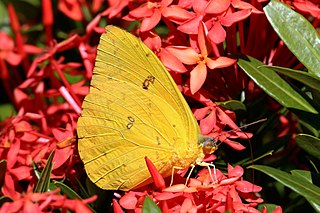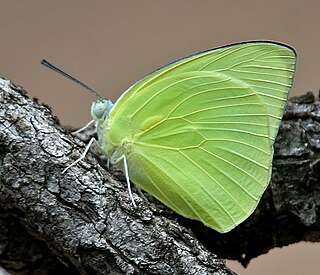
White Sulphur Springs is a city in Greenbrier County in southeastern West Virginia, United States. The population was 2,231 at the 2020 census. The city emblem consists of five dandelion flowers and the citizens celebrate spring with an annual Dandelion Festival.

The Pieridae are a large family of butterflies with about 76 genera containing about 1,100 species, mostly from tropical Africa and tropical Asia with some varieties in the more northern regions of North America and Eurasia. Most pierid butterflies are white, yellow, or orange in coloration, often with black spots. The pigments that give the distinct coloring to these butterflies are derived from waste products in the body and are a characteristic of this family. The family was created by William John Swainson in 1820.

Phoebis sennae, the cloudless sulphur, is a mid-sized butterfly in the family Pieridae found in the Americas. There are several similar species such as the yellow angled-sulphur, which has angled wings, statira sulphur, and other sulphurs, which are much smaller. The species name comes from the genus Senna to which many of the larval host plants belong.

Coliadinae, the sulphurs or yellows, are a subfamily of butterflies with about 300 described species.

A deep-submergence rescue vehicle (DSRV) is a type of deep-submergence vehicle used for rescue of personnel from disabled submarines and submersibles. While DSRV is the term most often used by the United States Navy, other nations have different designations for their equivalent vehicles.

Catopsilia pomona, the common emigrant or lemon emigrant, is a medium-sized pierid butterfly found in Asia and parts of Australia. The species gets its name from its habit of migration. Some early authors considered them as two distinct species Catopsilia crocale and Catopsilia pomona.

A submarine rescue ship is a surface support ship for submarine rescue and deep-sea salvage operations. Methods employed include the McCann Rescue Chamber, deep-submergence rescue vehicles (DSRV's) and diving operations.

Anteos clorinde, the white angled-sulphur or the ghost brimstone, is a butterfly of the family Pieridae. The species was originally described by Jean-Baptiste Godart in 1824.

Anteos maerula, the angled sulphur or yellow angled-sulphur, is a butterfly of the family Pieridae. It is found from Peru to Mexico. Rarely, migrants can be found up to eastern Nebraska, south-eastern Arizona, south-western New Mexico, southern Texas, Mississippi and Florida.

Anteos menippe, the great orange tip or orange-tipped angled-sulphur, is a neotropical butterfly of the family Pieridae.
Sulfuric acid poisoning refers to ingestion of sulfuric acid, found in lead-acid batteries and some metal cleaners, pool cleaners, drain cleaners and anti-rust products.

SRV-300 is a deep-submergence rescue vehicle that is rated to dive up to 300 m (980 ft). It was built by DRASS (Livorno) for the Marina Militare, and is capable of descending to 300 metres (980 ft) carrying 12 passengers in addition to crew. SRV-300 is hosted by Anteo, berthed at La Spezia.
MSM-1 USEL was a deep-submergence rescue vehicle (DSRV) that was rated to dive up to 600 m (1,969 ft). It was built by Cantieri Navali Ernesto Breda/Fincantieri for the Marina Militare. The sub was capable of descending to 600 metres (2,000 ft) below the surface and could carry 8 passengers at a time in addition to her crew. MSM-1 USEL was hosted by mother ship Anteo at La Spezia from 1980 to 2002. That year MSM-1 USEL was replaced by the DRASS Galeazzi SRV-300.
The Worldwide Machine, also translated as The World Machine, is a 1965 philosophical novel by Italian writer Paolo Volponi. An English translation by Belén Sevareid was published by Grossman Publishers in 1967. A new translation by Richard Dixon was published by Seagull Books and University of Chicago Press in 2024.











